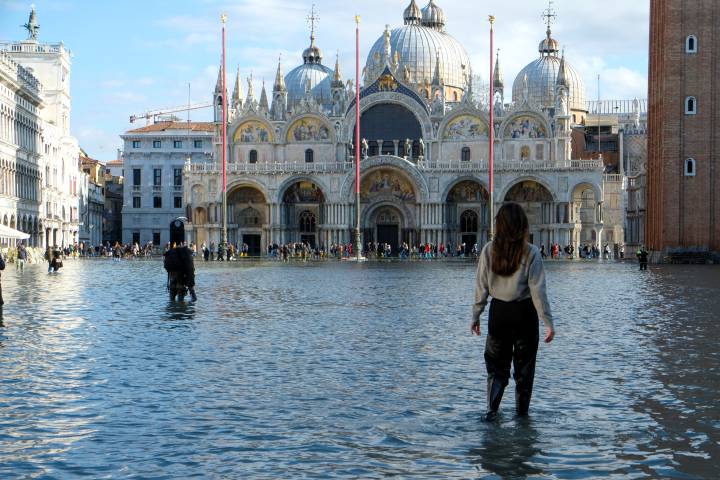VENICE: Italy on Thursday declared a state of emergency for Venice after an exceptional tide surged through churches, shops and homes, causing millions of euros worth of damage to the UNESCO city.
Prime Minister Giuseppe Conte said the cabinet had approved the state of emergency and ordered the immediate release of 20 million euros (USD 22 million) in funds for “the most urgent interventions” in the devastated city after Tuesday’s flooding.
Despite the emergency, tourists larked around in the flooded St Mark’s Square in the sunshine, snapping selfies in their neon plastic boots and taking advantage of a respite in bad weather which has driven the high tides.
Sirens warning of fresh flooding rang through the canal city early Thursday but the water level remained low compared to Tuesday’s tide, the highest in 50 years. Conte, who has called the flooding “a blow to the heart of our country”, met Venice’s mayor and emergency services before jumping in a speed boat to visit businesses and locals affected by the tide.
Residents whose houses had been hit would immediately get up to 5,000 euros in government aid, while restaurant and shop owners could receive up to 20,000 euros and apply for more later, he said. Several museums remained closed to the public on Thursday.
As authorities assessed the extent of the damage to Venice’s cultural treasures, such as St Mark’s Basilica where water invaded the crypt, locals were defiant. Many stopped for their habitual coffees at flooded bars, drinking their espresso while standing in several inches of water.
Austrian tourist Cornelia Litschauer, 28, said she felt mixed emotions seeing Venice’s famous square half submerged. “For the tourists it’s amazing, it’s something to see. But for the people who live here it’s a real problem,” Litschauer said, cradling her white Chihuahua Pablo.
“It’s strange. Tourists are taking pictures but the city is suffering.”
The Locanda Al Leon hotel said its bookings had suffered from the international media coverage of the flood, with some guests cancelling their rooms after seeing images of Venice underwater.
Under the arches of the Ducal Palace, a couple from Hong Kong posed for photos in the chilly morning sun. “This (trip) was planned a long time ago so we couldn’t change it,” groom Jay Wong, 34, said. “Actually this is a good experience. It’s an adventure.” Tuesday’s “acqua alta,” or high waters, submerged around 80 percent of the city, officials said.
Only once since records began in 1923 has the water crept even higher, reaching 1.94 metres in 1966. Former Prime Minister Silvio Berlusconi arrived for a private tour of the damage sustained to the basilica, while rival leader of the Italian right Matteo Salvini was due to drop by for the same on Friday.
French tourist Manon Gaudre, 22, said seeing Venice submerged was a “unique experience”.
“The damage it’s causing to monuments and the people is worrying,” she said, wondering if climate change was to blame. Many, including Venice’s mayor, have blamed the disaster on global warming and warned that Italy — a country prone to natural disasters — must wake up to the risks posed by ever more volatile seasons.
“We need to be resilient and adapt. We need a policy that looks at the climate through completely different eyes,” Environment Minister Sergio Costa said Thursday. Mayor Luigi Brugnaro has estimated the damage to Venice at hundreds of millions of euros. The Serenissima, as the floating city is called, is home to a mere 50,000 residents but receives 36 million global visitors each year.
A massive infrastructure project called MOSE has been under way since 2003 to protect the city, but it has been plagued by cost overruns, corruption scandals and delays. “This engineering solution that will end up costing nearly six billion euros has got to work,” Transport Minister Paola De Micheli said. The plan involves 78 gates that can be raised to protect Venice’s lagoon during high tides — but a recent attempt to test part of it caused worrying vibrations and engineers discovered it had rusted. AFP







